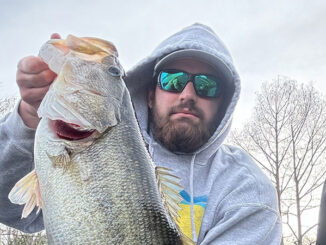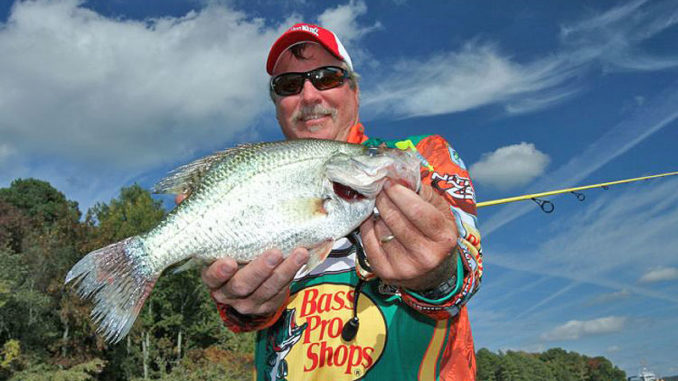
When baitfish go deep in colder months, crappie follow them. Try these tips to load up on winter slabs.
Winter crappie fishermen are deep thinkers; but don’t be intimidated if your name doesn’t include a PhD, MBA or some other evidence of academic ascension. Truth be told, all you really need to know is this: Where’s the deep water?
On his Toledo Bend home waters, crappie guide Jerry Thompson looks for his best winter action in creek channels. On natural lakes without a river, Thompson points anglers to the deepest water they can find. But in reservoirs like Lake D’Arbonne and Toledo, your major creeks are the deal.
“The crappie go to those creek channels because they’re following the shad,” Thompson said. “The baitfish go to the deepest water available to them and the crappie follow them. So, if you’ll concentrate on the creek channels — not the river channel — that’s where the majority of fish are going to be.”
As Thompson noted, any hard structures in the channel are definitely worth investigating, but day in and day out, it’s all about the food. Same as bass, crappie want to keep the baitfish buffet in front of their noses.
“It’s mostly to do with shad, but crappie like cover, so any logs or stumps are good,” Thompson said. “Sometimes you can catch them on just an old sand bar. When they’re on something open like that, I think it has to do with the shad.”
On Toledo, Thompson spends a lot of his winter crappie time at the Chicken Coop — a mile stretch of river running against an east-facing mid-lake bank. The spot holds some of the lake’s coolest water, but crappie gather there in massive numbers — again, because of the voluminous shad schools. Such scenes replicate in varying degrees elsewhere on Toledo and in other lakes; just look for that deep water and big balls of shad hugging a bluff bank.
Likely neighborhoods
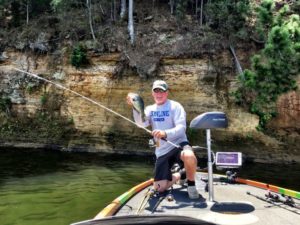
Bassmaster Elite Series pro Jason Christie’s a big fan of winter crappie for a couple of reasons. For one thing, he likes to stay sharp during the off-season so he’s not rusty for each new year; but after several months of the bass tournament grind, he finds crappie offer a nice transitional target.
In addition to channel edges, Christie likes fishing vertically around standing timber and brush piles. In any of these scenarios, the straight up-and-down look best fits the winter season.
“I’m fishing for suspended fish and if you were casting a bait, it would be really difficult to keep it in the strike zone,” Christie said. “You might make some casts and catch the aggressive ones, but I want to put that bait right in front of them.
“A lot of times, I may drop in the middle of 30 to 40 fish and still, it may take 5 to 10 seconds to get one to bite. I think they’re moody this time of year; there are days when they’ll bite it as soon as they get down there, and then there are days when you have to hang that bait right there in front of them.”
One thing Christie stresses is proper bait positioning. With eyes positioned at the top of their head, crappie were built for looking upward — and feeding likewise.
“I’ll drop my bait a foot or two above their head and let them come get it. It seems if I even get an inch below their bellies, it’s hard to get a bite. They want to swim up to get that bait.”
Chilly meals
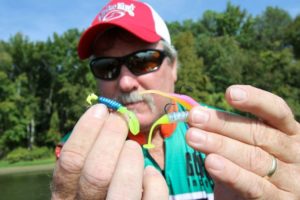
Thompson’s fellow Toledo Bend guide Dennis Tietje said that water temperature dictates winter crappie movement. If a mild season keeps the water in the upper 40s and higher, the fish may remain shallower on brush, where floating a light jig tipped with a Berkley Crappie Nibble gets plenty of attention.
For the deeper stuff, Christie likes a small tube with a ¼-ounce jighead on spinning tackle and 6- or 8-pound fluorocarbon. His advice: Keep it simple with minimal colors.
“I carry only one color (black with chartreuse skirt) because I’m looking for schools of fish that have never seen a crappie jig, so it’s not about (multiple colors); it’s about putting a bait in front of them,” he said. “I’ve had a lot of people in my boat and they see me pull out my one box with one color tube and they have their 15 colors and before long, they’re borrowing the colors I have.
“If I see fish on my electronics, I drop and tight line the bait, so I want something pretty heavy so I can feel that bite. It’s actually not a bite; the line will just go slack. Also, I want a bigger hook because a lot of the fish you’ll catch this time of year are nice ones and you pull them out of trees or brush, you don’t want that hook to flex too much.”
Live minnows
Thompson likes feeding the fish live minnows and he uses a simple rig with a size 0 or 00 pinch-on weight about a foot above a No. 2 Aberdeen hook. He may go to a No. 1 hook for hefty minnows or drop to a No. 4 if he can only get small baits.
“You want to give that minnow room to swim around down there,” Thompson said. “I use the weight because I want to get the bait down to deep fish and I don’t want to wait all day.”
Occasionally, Thompson will mix it up by dropping a Berkley Powerbait Smelt on a 1/16-ounce jighead with a split shot above for extra drop speed.
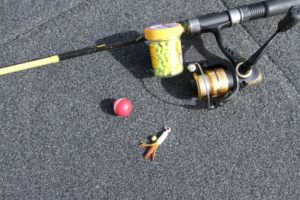
“They don’t necessarily get on the bottom, but sometimes they do,” Thompson said. “The best time to catch a crappie on the bottom is in the winter.”
Presentation
Bites can be super subtle, so Thompson advises focused rod attention and a disciplined response. You won’t often feel a spirited tug like bluegill gobbling earthworms, so dial in your sensitivity to winter crappie mode.
“Let him eat it and feel for the weight,” Thompson said. “Don’t feel for the nibbles — just wait for the weight. Those crappie are there to feed up for their spawn and when they’re like that, they’re eating so they’ll get the hook.”
Tietje agrees that the vertical presentations make up the majority of winter work; but if you’re having trouble finding crappie, he suggests slow trolling a mix of jig styles (include bladed offerings like Roadrunners) across likely areas. As he explains, you’re still using a nearly vertical presentation, but you’re creeping along a contour line or an attractive stretch of standing timber.
However you catch your crappies, eat ‘em fresh when you can and freeze unused filets for future meals.
Tip: Freezing filets in water yields soggy, mushy meat when thawed. Rather, vacuum seal what’s freezer bound and you can look forward to many fine meals throughout the winter months.
Looking and locating
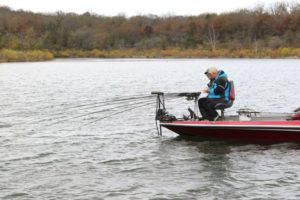
Dennis Tietje, Toledo Bend guide, said that slow trolling baits — actually more of a glacially-paced tight-lining deal — is a simple way to cover water and locate crappie concentrations. However, scanning promising areas proves more time-efficient.
“This time of year, they’re bunched up, so going over them won’t affect them,” said Tietje’s fellow Toledo Bend guide Jerry Thompson. “You’ll find them in wads. You’ll know when you see them; they look like Cheese Puffs.
“When you find them, there’s not much in the way of adverse conditions that will affect them, except for big winds or heavy rains. They’re so deep, not much affects them.”
Bassmaster Elite pro and winter crappie fan Jason Christie depends heavily on his electronics because winter fish tend to move around a lot as they follow wandering bait schools. Using his Garmin Panoptix, which shoots a sonar beam off the trolling motor transducer to show him a bottom-to-surface picture of the water column, Christie expects to have to reacquire schools on every outing.
“These fish don’t just move laterally, the ones on timber also move vertically,” he said. “Some days they’re going to put their belly on the bottom and some days they’re going to get up there and get some of that sunlight and feed aggressively.”
The unexpected
Complicating the search is the often particular preferences that pull crappie to less obvious structure. For example, Christie said he’s seen a substantial tree skeleton 20 yards from a nondescript pole — and the latter is haired over with crappie.
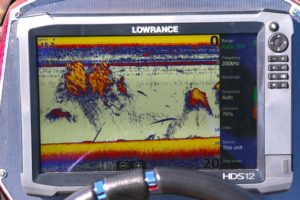
“That pole would be hard to find with regular DownVu and SideVu; but with Panoptix, I’ll look around while I’m fishing and a lot of times, I’ll find a little piece of structure.
“Most days, I don’t even have to pick up the trolling motor; I’ll just fish around a pocket and I’ll find so many little sticks that I may catch five to 10 off of. Then, I’ll move up 50 yards and find another piece of structure.”
As Christie observes, leveraging modern forward-looking sonar improves time management in two ways: First, you’ll locate your targets more quickly. Also, knowing the spot’s potential helps you manage expectations.
“The cool thing is, you know how many fish are on the spot,” he said. “You’ll find a wad of 15 to 20 fish and after 15 minutes it gets tougher to catch any. You may look at that spot and see that there’s only one or two left. You know what’s there when you arrive and what’s there when you leave.”
Also advantageous is the ability to watch the forward-looking sonar and monitor a bait’s movement through the water column.
“In the old days, you had to cast your crappie jig and get that perfect count down before you started reeling to bring your bait through the fish,” Christie said. “I want that bait about two feet above the fish and the Panoptix takes the guesswork out of it.”

